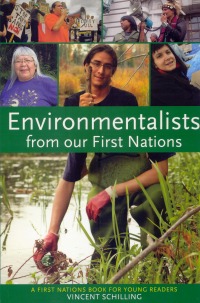| ________________
CM . . . . Volume XVIII Number 20 . . . . January 27, 2012
Education for Sustainable Development (ESD) has been a focus of scholarly and professional attention in Canada in recent years. Government, teaching professionals, scholars and the general public are becoming progressively more aware of the importance of environmental stewardship and sustainable living. As an educational imperative for primary and secondary schools in Canada, the ESD movement has developed concurrently with the Aboriginal education movement. Many have cited the meaningful spiritual and communal connections between environmental stewardship and the traditional holistic perspectives that are held by Aboriginal peoples in Canada. These perspectives have important implications in the understanding and appreciation of how Canada’s first peoples view, among other things, the environment, different forms of life, relationships, and spirituality. The spiritual and cultural connections to the environment that can be associated with the Aboriginal peoples of Canada comprise an integral part of the holistic worldviews that are held by many Aboriginal peoples. Numerous organizations and communities have ventured to illustrate the holistic worldviews, as they apply to learning, of the First Nations, Métis, and Inuit peoples of Canada. In employing an Aboriginal worldview such as these, the possibilities for enhanced educational programming that adheres to the principal tenets of ESD are encouraging. One of the major challenges for making use of such worldviews as a means of facilitating peoples’ acceptance of responsibility as stewards of the environment is the process of placing the values for environmental stewardship into the individual and collective consciousnesses of a community. Environmentalists From Our First Nations explores the discussions associated with the imperatives associated with environmental stewardship and how First Nations knowledge, heritage, consciousness and tradition can inform desired change. In reading Environmentalists From Our First Nations, I was reminded of the Canadian Council of Learning’s work in the area of holistic life-long learning. In reflecting a model for holism associated with Métis peoples, the CCL asserted that:
Ecological dimensions to indigenous life, frequently comprised of a spiritual dimension, have informed Shillings work. In a volume that ventures to explore a diverse and rich set of narratives, Environmentalists From Our First Nations provides readers with the stories of 10 First Nations activists from across North America whose views on how we can combat environmental degradation have been informed by their indigenous perspectives on our relationships with nature and with one another. The stories contained in this book tell of political and social activism as well as of adherence to community-based values that emphasizes reverence, reciprocity, and respect for the natural environment. The development of the Environmentalists From Our First Nations appears to have been predicated, in part, by the notion that First Nations peoples have a history with others where marginalization, segregation, and other hegemonic activities on the part of various oppressors have negatively impacted upon their state of being. At a time when these histories have become an increasingly significant part of the public consciousness, the indigenous rights movements of Canada and America have taken hold in many socio-political forums. The indigenous rights movement has allowed the development of two principal imperatives for First Nations peoples: self-government and the settlement of land claims. Both of these imperatives, which are popularly understood as struggles for political power and financial gain, do have intimate connections with the lands in question and are the subject of many scholarly discussions. Much of the literature that either examines or alludes to the connection between Aboriginal peoples and the environment places Aboriginal perspectives in contrast to modernistic, Eurocentric perspectives on societal growth, progress, and financial gain. In exploring the story of Clayton Thomas-Muller, this book illustrated this dichotomous relationship by pointing out that:
These sentiments have been manifest in instances where Indigenous knowledge and its connection with the environment stand in clear contrast to scholarly discourse, social discussions, and activities that support such things as anthropological and archaeological research, resource extraction to sustain commerce, and social sentiments that support emergent and existing postcolonial and neoliberal attitudes of hegemonic domination on the part of a government, steeped in traditions of the Westminster style of parliamentary democracy, that has perpetuated a social hierarchy throughout its history. Environmentalists From Our First Nations would be of interest to teachers who wish to explore Environmental Stewardship and/or Education for Sustainable Development in their classes. This book is suited for high school students but may be suited for those in middle school as well. Recommended. Frank Deer is an assistant professor in the Faculty of Education at the University of Manitoba in Winnipeg, MB.
To comment
on this title or this review, send mail to cm@umanitoba.ca.
Copyright © the Manitoba Library Association. Reproduction for personal
use is permitted only if this copyright notice is maintained. Any
other reproduction is prohibited without permission.
NEXT REVIEW |
TABLE OF CONTENTS FOR THIS ISSUE
- January 27, 2012.
AUTHORS |
TITLES |
MEDIA REVIEWS |
PROFILES |
BACK ISSUES |
SEARCH |
CMARCHIVE |
HOME |
